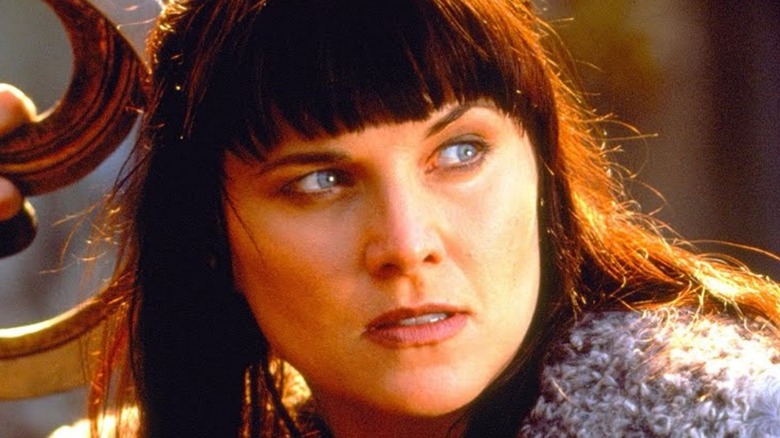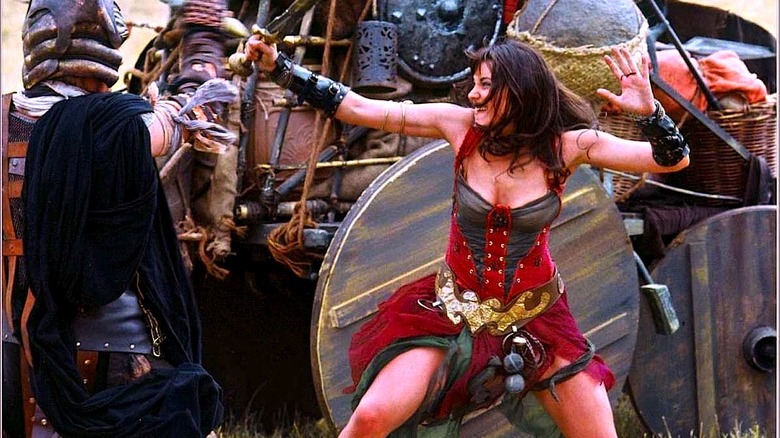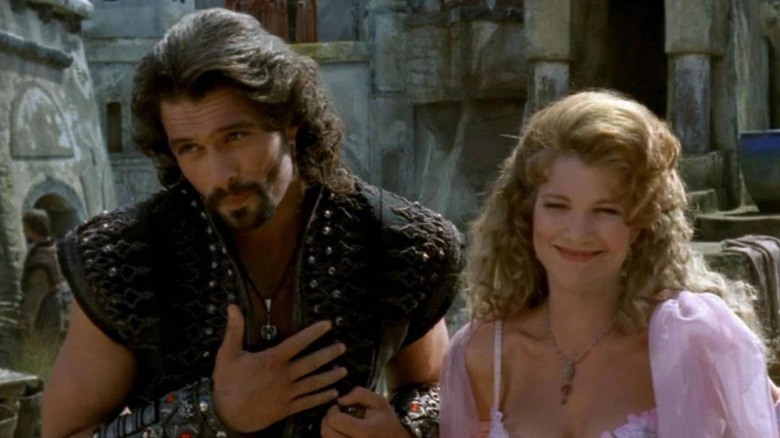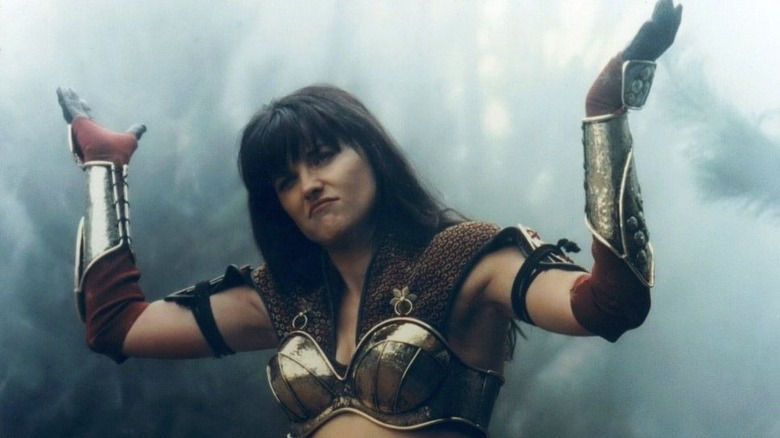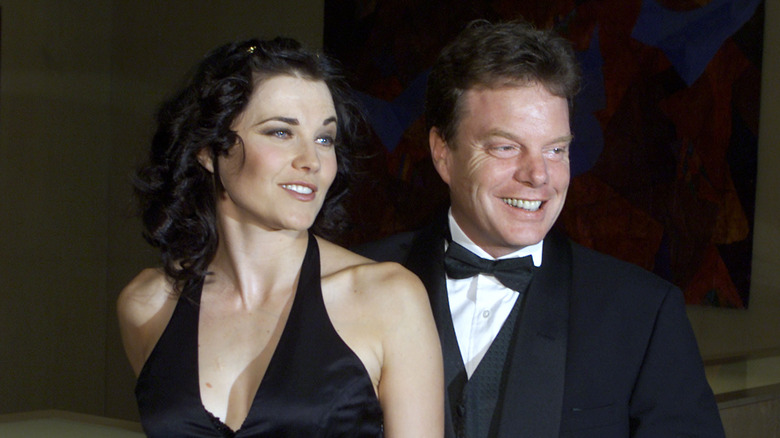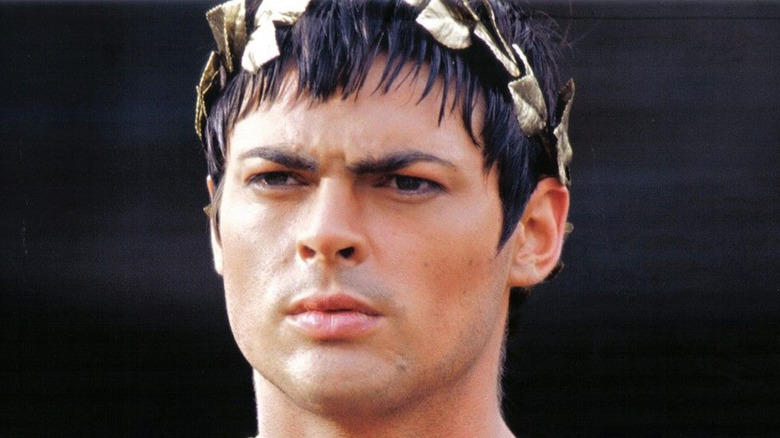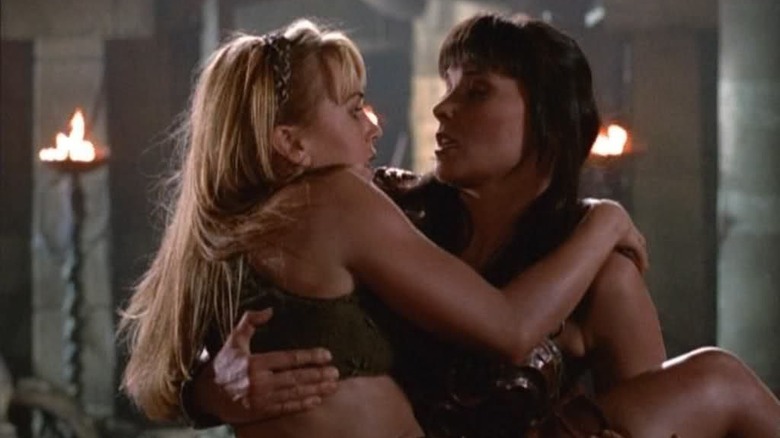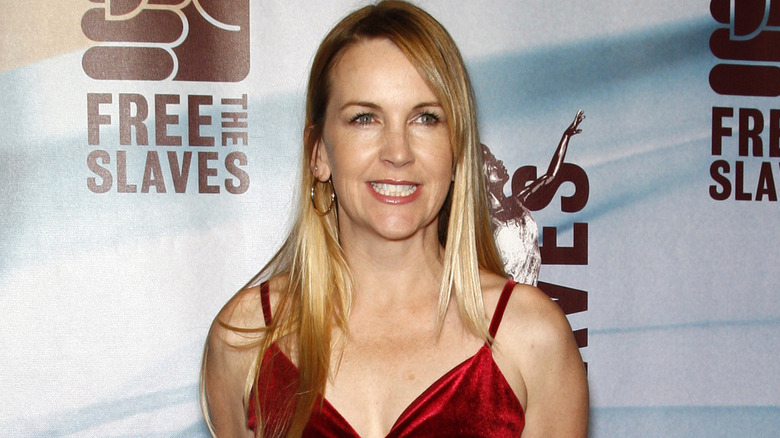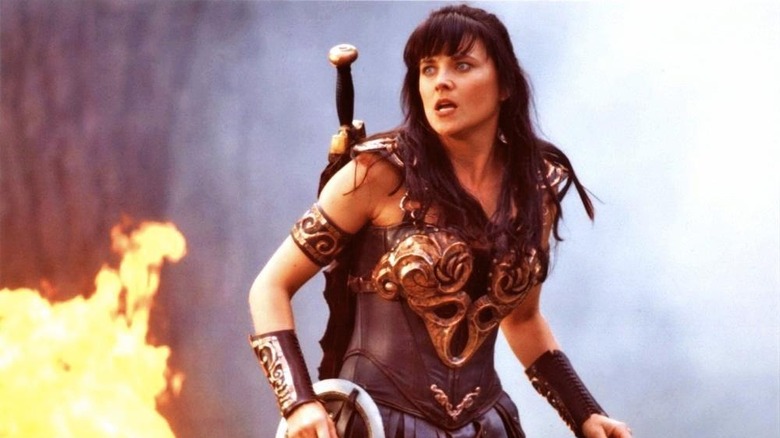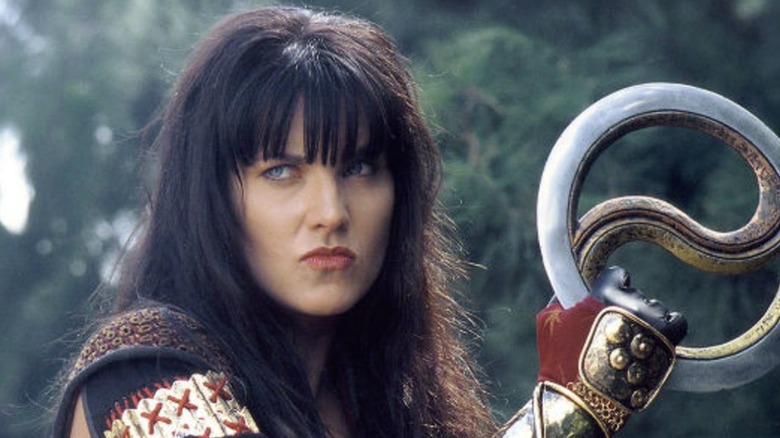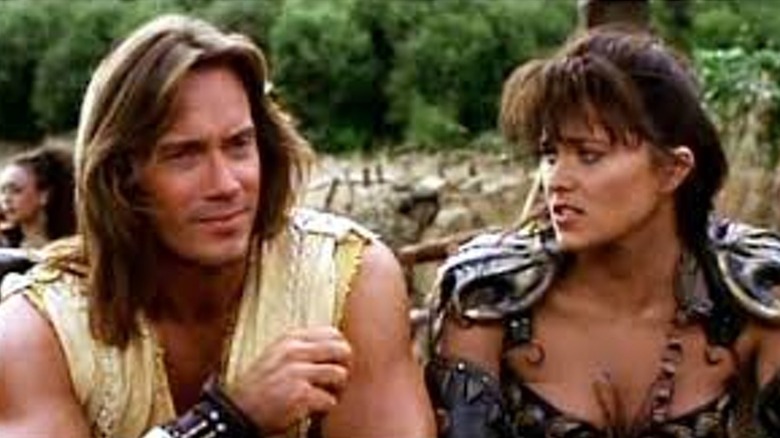The Untold Truth Of Xena: Warrior Princess
When Xena first showed up as a character on "Hercules: The Legendary Journeys," there was no way anyone could have predicted that audiences would still be talking about her, decades later. How big of a phenomenon was "Xena: Warrior Princess"? Well, Lucy Lawless, who portrayed Xena with inimitable charisma, has since added many credits to her resume, yet her Encyclopedia Britannica entry mentions Xena before any of her other roles.
"Xena: Warrior Princess" debuted on September 4, 1995, and ended on June 18, 2001. It aired in over 100 countries, and generated a dedicated fanbase that has kept the show in the popular consciousness for many years. Fan sites such as Xenaville are still being updated, while Whoosh.org, which deems itself the "Birthplace of the International Association of Xena Studies," remains available for all your "Xena"-related needs. Looking for some real-life fun? "Xena" conventions are still happening, complete with archery lessons and hiking. Want to contemplate the historical importance of your favorite chakram-wielding princess? Xena's duds can be found in the Smithsonian Institution. "Xena: Warrior Princess" is such a phenomenon, Subaru once referenced the show in a ground-breaking ad campaign.
What is it about this show that has led to such fan devotion, even after all these years? We're here to answer that very question. This is the untold truth of "Xena: Warrior Princess," from the real-world history of chakram to the unforgettable bond between Xena and Gabrielle.
Xena was supposed to be killed off
The character of Xena made her first appearance on "Hercules: The Legendary Journeys" as a villainous warlord, out to kill Kevin Sorbo's Hercules. Her arc was supposed to end with her death. Instead, the character proved so popular that she earned a spin-off.
In the "Hercules" episode "The Warrior Princess," Xena's fighting prowess is on full display, though her outfit is not yet the iconic one worn in her series. Xena's goal is to seduce Michael Hurst's Iolaus, Hercules' best bud, in order to get close enough to Herc to kill him. In her next episode, "The Gauntlet," she finally gets close to Hercules, but in the final episode of her trilogy, "Unchained Heart," Xena reforms herself and goes off to make amends for her treacherous past.
This wasn't Lucy Lawless' first time on the show, believe it or not. She'd already appeared in a smaller role as Lyla, the wife of a centaur, in Season 1, Episode 6, "As Darkness Falls." Before that, she'd popped up as Lysia in the 1994 "Hercules and the Amazon Women" TV movie. When the actress originally cast as Xena, Vanessa Angel, became ill, Lawless got the part. The rest is television history.
Xena might be a demi-goddess
Like "Hercules," its parent show, "Xena: Warrior Princess" is steeped in Greek mythology. Though it's never said outright, it's certainly implied that Xena might be an outright demi-goddess. Her mother, Cyrene, shares a name with a legendary water nymph. Moreover, it's hinted in "The Furies" that Xena's father is Ares, the Greek god of war. Considering the often-flirtatious nature of Ares and Xena's interactions, that would be, um, not great by current standards, but totally in line with Greek myth.
Xena being a demi-goddess would certainly explain her beyond-human fighting feats, and her ability to hold her own against the various gods and goddesses she encounters and frequently defeats. Granted, doing things like running on top of other warriors' heads with apparent ease may merely mean Xena is super-agile, and possibly a wuxia master. As producer Rob Tapert once told The New York Times, Xena's fighting style is based off Brigitte Lin's, star of the 1993 Hong Kong martial arts film, "The Bride with White Hair." However, Xena routinely kicking divine butt puts her on par with a fully-powered Hercules. Some godly parentage would make that a whole lot more plausible.
Xena's ratings outdid Hercules'
"Xena: Warrior Princess" began with much promise, having been spun-off from a popular action-fantasy show based on the strength of three episodes and the immense charisma of its star. "Hercules: The Legendary Journeys" was already solidly established: It managed to head off competition from "Star Trek: Deep Space Nine," and even topped "Baywatch." However, it didn't take long for "Xena" to start surpassing it.
"Xena" eventually joined "Hercules" in beating out "Baywatch" in 1996. Besting "Hercules" was something "Xena" kept doing, hitting a ratings high of 7.8 the week of February 23, 1997. Eventually, "Xena" even managed to wrestle the top syndication spot away from the ratings behemoth that was "Star Trek: The Next Generation." As reported in The Daily Universe, Rob Tapert told TV Guide, "Our initial goal was to bump off 'Baywatch' as the No. 2 show. This is something I never expected to accomplish."
Like many shows, "Xena: Warrior Princess" had its ups and downs in the ratings. But it continued to maintain its popularity over "Hercules: The Legendary Journeys:" Not only did it last longer, its series finale also scored higher ratings.
Lucy Lawless met her husband in the Xenaverse
In 1988, Lucy Ryan married Garth Lawless. The couple had a child, Daisy, and divorced in 1995. Lawless went on to meet Rob Tapert, an executive producer on "Hercules: The Legendary Journeys" and "Xena: Warrior Princess" after she was cast. The two were wed in 1998. That's right — it's a match made in the Xenaverse. However, Lawless and Tapert did not date right away: It took a couple of years before they were even officially an item. As Lawless told People Magazine, Tapert "is the finest man I've ever known." The pair have two sons, Julius and Judah.
The couple continues to collaborate on projects. Lawless had roles in two of Tapert's other television shows, "Spartacus: Blood and Sand" and "Ash vs. Evil Dead." She also starred in Tapert's 2017 musical "Pleasuredome," which he co-wrote with Mark Beesley. Iolaus himself, Michael Hurst, directed the production, making "Pleasuredome" a "Xena"-riffic affair. The production enjoyed a limited run in New Zealand.
From niche roles to major stars
"Xena: Warrior Princess" features plenty of then-small-time actors who have gone on to do big things. If you had to winnow the list down to the two biggest actors to guest on "Xena: Warrior Princess," however, you'd end up with a pair of major names: Bruce Campbell, who played Autolycus, and Karl Urban, who played several roles on the show, including Julius Caesar.
Campbell, who is internationally renowned as Ash Williams of the "Evil Dead" franchise, had a role in one of the most important scenes in the show's history: Autolycus kisses Gabrielle while he is possessed by Xena. Campbell spoke fondly of his time as Autolycus on the "Xena 25" podcast, and espoused the belief that the show had more of an impact than "Hercules" because of its complexity. He expressed delight at seeing fans dressed as Autolycus so many years later: "Anything that has resonance decades later ... means it was worth doing." He further described the role as "perfect for [his] sensibilities."
Karl Urban has gone far since his early days on "Xena:" He's beloved for his work on "The Boys" and major franchises including the MCU, "The Lord of the Rings," and "Star Trek." Urban told Whoosh.org in 1998 that he enjoyed working on "Xena" and "Hercules" due to the shows' environments: "You get on set there and we have fun. It's like a family." He also hailed "Xena" as a "great kind of training ground" at Fan Expo 2013.
Xena boasts a long convention history
When "Xena: Warrior Princess" began airing, fan conventions were still fairly niche. So when Creation Entertainment, which has been hosting fan conventions since 1971, held a small event in 1997 dedicated to "Xena" and "Hercules," it was a big deal. When it was promoted to a "full scale touring convention" in 1999, it was an even bigger deal.
Guests at the first event included Lucy Lawless, Kevin Sorbo, and Renée O'Connor. The first two events proved so popular that Creation had to expand the convention to larger venues to accommodate fan demand. As The Los Angeles Times reported in 1998, "Hercules" fans were scarce compared to the "Xenites," a fan-created term for "Xena" lovers. Still, a good time was had by all. Scroll through photos and videos of these events, and you'll spy a then-unknown Ryan Gosling, there to promote "Young Hercules," and Karl Urban covering The Beatles. Creation alone could not satisfy the Xenites' enthusiasm: Several other "Xena" conventions and events popped up across the United States, everywhere from Las Vegas to New York City.
After the final "Xena" convention took place in 2015, a "Xenite Retreat" cropped up. Here, fans enjoy creative workshops, go hiking, catch fish, explore athletics, and, of course, chat about "Xena." Yet even that isn't the only option available to the modern "Xena" fan: "A Salute to Xena,"a 25th anniversary convention, was announced in 2020.
Xena is an LGBTQ+ icon
Xena and Gabrielle's subtextual love story is a big part of why "Xena" became such a sensation. Though nothing was ever made irrefutably explicit, that didn't stop the LGBTQ+ community from embracing the show wholeheartedly. As Pacific Standard notes, some fans "were disappointed that the Xena and Gabrielle characters were never openly queer," a la Willow and Tara of "Buffy the Vampire Slayer" fame. Still, it can't be denied that "Xena" blazed a major trail.
Though the show doesn't make Xena and Gabrielle's romantic relationship canonical, the current comic book series has no such restraints: There, Xena and Gabrielle as portrayed as being in a long-term relationship. Lawless herself described Xena as gay as early as 2003, even deeming the pair to be essentially married. For her part, Lawless has always expressed delight at being considered a gay icon: As she told Out Magazine in 2003, "I've always been grateful to [lesbian fans] for picking up on my show first. I feel they made it hip."
Renée O'Connor does it all
Renée O'Connor might be best known as Gabrielle, but in fact, she's a Jill of all trades. She directed two episodes of "Xena:" 1999's "Deja Vu All Over Again" and 2001's "Dangerous Prey." Since her days on the show came to an end, she's tapped into other talents, including producing, stage acting, teaching, podcasting, and art. Most prominently, O'Connor has her own company, ROC Productions, which provides video production services and has produced films including 2017's "Watch the Sky" and 2016's "The Usual."
O'Connor has quite a bit of experience performing on stage, taking on such meaty roles as Lady Macbeth. She also teaches classes on Shakespeare's monologues and on Sanford Meisner's acting techniques. Teaching has had to take a backseat recently, however, as O'Connor has focused on producing a podcast on the culture of 1960s Austin. On top of all of this, O'Connor is also an accomplished painter.
Even with all that under her belt, O'Connor has said she'd play Gabrielle again if the show was ever revived. "I would love to revisit these characters again," she said in 2017. "Obviously, it would be a completely different experience, but I think it would be really interesting if that came up [and] if we could actually play the same characters."
Xena's costume is displayed in two museums
Xena's costume is a big part of what makes her instantly recognizable. It's so iconic, in fact, that it's ensconced in two museums. One costume was donated in 2001 to the Museum of New Zealand Te Papa Tongarewa, while Lawless donated the other to the Smithsonian Institution's National Museum of American History.
Xena's legendary look is detailed and intricate, incorporating materials like leather, mother of pearl, and brass. Barbara Darragh, the costume's designer, says she took inspiration from art nouveau, among other movements and eras. One of the more interesting details of the costume is the size of the boots. Does Xena have huge feet? Not exactly: The boots actually contain running shoes, to allow Lawless more comfort and freedom of movement. Hopefully, this made up for the boning in the corset, which was tight enough to make Lawless uncomfortable.
The popularity of Xena's costume ultimately extended to a truly unusual place: The United States military. Back in 2012, the military reportedly looked to Xena's outfit when considering how to redesign body armor to better protect female soldiers, according to The Christian Science Monitor.
Xena's chakram are totally real
Though she's proficient with just about everything, Xena's favorite weapon is her chakram. She gains multiple chakram throughout the series, including the Dark Chakram, the Light Chakram, and the Yin-Yang Chakram, which can break into two halves to be used separately. Though Xena's magical weapon is fictional, the chakram is actually a real South Asian weapon. Wielded by Vishnu, one of Hinduism's major deities, the chakram "symbolizes clearing of the path to God," according to York University's Aruna Panday.
In Entertainment Weekly's oral "herstory" of the show, Rob Tapert recalled director Doug Lefler coming up with the signature weapon rather casually: "[He] said, 'Hey, this is the object she should have when we find her in 'Hercules.' This round throwing object that shocked them — this should be the Warrior Princess' weapon.'" Although the show's chakram were mostly harmless props (and often made of rubber, to be more easily tossed around), one metal chakram prop was actually dangerous: Its inlaid stones were made of abalone, which emits a toxic dust when ground. Real world chakram may not fly as magically as they do on the show, but they can still kill a person if they're made of abalone and assembled in an area without proper ventilation!
Lawless based Xena's war cry on the zaghrouta
A whole lot of care went into the development of Xena's character, from what she wears to who she loves to her unforgettable battle cry. As Lucy Lawless told PeopleTV, her future husband, Rob Tapert, decided that Xena needed a "signature call, like Tarzan had." Right around then, Lawless saw a funeral on TV where Arab women were ululating. Ululation is a type of trilling howl used to express strong emotion. In Xena's case, it's used as a clear and intimidating war cry. Lawless couldn't quite mimic what she saw on TV, so she "tweaked" it into her own thing. Thus, Xena gained her very own Tarzan-style howl.
The ululation Lawless heard that fateful day has a name: It's called the zaghrouta, and can be heard throughout the Middle East. It isn't restricted to funerals, and can be heard during happy occasions including weddings, graduations, and, in the case of pop star Shakira, who introduced much of the world to the zaghrouta during the 2020 Super Bowl halftime show, musical performances.
Xena and Hercules' actors don't get along
After the U.S. Capitol was stormed by a violent mob on January 6, 2021, "Hercules" star Kevin Sorbo took to Twitter to spread the unsubstantiated conspiracy theory that the rioters were left-wing activists in disguise. Lucy Lawless responded swiftly with a tweet of her own, calling Sorbo an "enabler" of "homegrown terrorists."
This is not the first time the two actors have had beef. In the wake of this exchange, Newsweek published a full timeline of their feud – though in truth, most of the animosity seems to come from Sorbo. Back in 2001, Sorbo excoriated "Xena: Warrior Princess" for not espousing the sort of "family values" allegedly embraced by "Hercules: The Legendary Journeys." He also complained that "Xena" poached much of the "Hercules" crew. Sorbo has since implied Lawless is a closeted lesbian, and that she has seduced her way into roles. As celebrity Chrissy Teigen once witheringly told Sorbo over Twitter, "hot take, boy xena."
